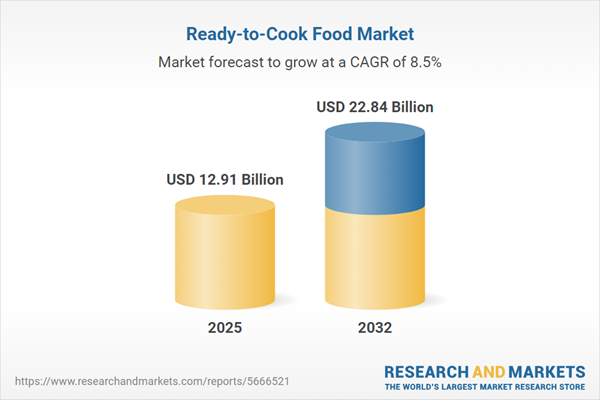Speak directly to the analyst to clarify any post sales queries you may have.
The ready-to-cook food market is rapidly evolving as senior executives navigate regulatory changes, adopt digital innovations, and align with shifting consumer needs. Organizations proactive in operational agility, advanced technology, and sustainable practices are better positioned to capitalize on emerging opportunities in this dynamic sector.
Market Snapshot: Ready-to-Cook Food Market Size and Growth
The global ready-to-cook food market reached USD 11.87 billion in 2024 and is projected to grow to USD 12.91 billion in 2025, demonstrating an 8.51% compound annual growth rate. This accelerated growth is driven by the rising adoption of convenience foods, remarkable product innovation, and the increasing importance of omnichannel distribution strategies. Manufacturers and distributors benefit from strengthened digital infrastructure and expanded logistics, enabling fast adaptation to market shifts. Companies are shifting procurement priorities toward resilient supply chains and investing strategically in specialized distribution assets for sustained competitive advantage.
Scope & Segmentation of the Ready-to-Cook Food Market
- Product Types: Meal kits and ready meals cater to a range of usage occasions and support diverse lifestyles through subscription services and retail networks, with formats for ambient, chilled, or frozen storage.
- Distribution Channels: Supermarkets, hypermarkets, convenience retailers, specialty outlets, and online platforms allow for broad access to both business and end-consumer segments across various regions.
- Packaging Formats: Bags, bowls, pouches, and trays are selected for regulatory compliance and operational efficiency, optimizing the supply chain and preserving quality throughout distribution.
- End Users: Solutions address both households and institutional customers—including catering services, restaurants, and foodservice operators—enabling flexibility and consistency for distinct operational requirements.
- Cuisine Types: Offerings encompass Asian, Latin American, Middle Eastern, and Western cuisines, supporting manufacturers looking to expand portfolios and appeal to both local and cross-cultural preferences.
- Regional Focus: Market strategies include the Americas, Europe, Middle East & Africa, and Asia-Pacific, with particular depth in the United States, China, India, and Germany, informing cross-border investment considerations.
- Key Companies Analyzed: Leading players such as Nestlé S.A., Conagra Brands, Tyson Foods, The Kraft Heinz Company, McCain Foods, Ajinomoto, Nomad Foods, Bakkavor Group, General Mills, and Nissin Foods Holdings are assessed for strategic direction and innovation.
Key Takeaways for Executive Leadership
- Digital procurement and analytics platforms enhance supplier diversity and speed strategic decision-making, resulting in stronger operational resilience.
- Product development aligned with modern compliance frameworks fosters trust among stakeholders and ensures continuous readiness for evolving regulatory landscapes.
- Integrated omnichannel and direct-to-consumer strategies deliver deeper consumer insights, supporting data-driven efforts in marketing, retention, and precise segmentation.
- New packaging technologies contribute to sustainable logistics and improved product quality while efficiently supporting end-to-end distribution processes.
- Shifting household demographics—especially among younger and professional segments—are intensifying expectations for convenience and driving ongoing product innovation.
- Expansion of partnerships with technology providers and suppliers is streamlining adaptation to regulatory and operational trends, enhancing business agility in competitive settings.
Tariff Impact and Supply Chain Resilience
Recent tariff shifts in the U.S. are encouraging executive teams to broaden supplier networks and consider nearshoring to reduce operational risks. Adoption of digital procurement solutions is further raising supply chain resilience, empowering companies to respond rapidly to evolving market and regulatory landscapes.
Research Methodology & Data Sources
This research is based on interviews with production, supply, and retail executives and is enriched by expert input from sustainability and food technology perspectives. Validation is provided through industry publications, proprietary data models, and scenario analysis, ensuring a reliable view of the ready-to-cook food market.
Why This Report Matters
- Senior decision-makers gain relevant frameworks and clear analysis to support confident, timely action in the ready-to-cook food sector.
- The segmentation and technology insights presented inform business expansion and supply chain strategies tailored to leading geographic markets.
- The included benchmarks streamline strategic evaluation of potential partners and ongoing adaptation in a fast-changing environment.
Conclusion
Senior leaders will find actionable guidance in this report, equipping them to pursue sustainable growth and identify new areas of opportunity as the ready-to-cook food market evolves.
Additional Product Information:
- Purchase of this report includes 1 year online access with quarterly updates.
- This report can be updated on request. Please contact our Customer Experience team using the Ask a Question widget on our website.
Table of Contents
3. Executive Summary
4. Market Overview
7. Cumulative Impact of Artificial Intelligence 2025
Companies Mentioned
The companies profiled in this Ready-to-Cook Food market report include:- Nestlé S.A.
- Conagra Brands, Inc.
- Tyson Foods, Inc.
- The Kraft Heinz Company
- McCain Foods Limited
- Ajinomoto Co., Inc.
- Nomad Foods Limited
- Bakkavor Group Limited
- General Mills, Inc.
- Nissin Foods Holdings Co., Ltd.
Table Information
| Report Attribute | Details |
|---|---|
| No. of Pages | 182 |
| Published | October 2025 |
| Forecast Period | 2025 - 2032 |
| Estimated Market Value ( USD | $ 12.91 Billion |
| Forecasted Market Value ( USD | $ 22.84 Billion |
| Compound Annual Growth Rate | 8.5% |
| Regions Covered | Global |
| No. of Companies Mentioned | 11 |









